A light that generates 10× the number of entangled photon pairs than any known photon source. A hand-held Raman spectrometer with MEMS scanning mirrors. An FDA-cleared semiconductor laser for treating glaucoma — smaller and less expensive than others on the market.
These technologies are among the 27 finalists for the 2020 Prism Awards, in categories ranging from communication, vision technology, and the life sciences to transportation, quality control, and health care.
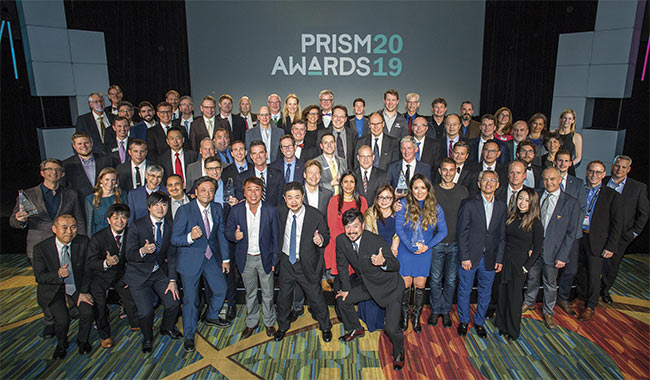
The 2019 Prism Award winners pose for a group photo. Courtesy of SPIE/Joey Cobbs Photography.
The Prism Awards ceremony and banquet, co-sponsored by SPIE and Photonics Media, will be held during SPIE Photonics West in San Francisco on Feb. 5. Presenters include Constantin L. Häfner, newly appointed Fraunhofer director; Daphnie Chakran, Spectrum Scientific president and CEO; and Dave Rego, Physik Instrumente vice president and general manager.
“The finalists for the 2020 Prism Awards represent the most exciting innovations in today’s thriving optics and photonics industry,” said SPIE CEO Kent Rochford. “From data centers and 5G networks to reducing CO2 and imaging our brains, photonics continues to impact and enhance our daily lives, and it’s been thrilling to see the variety of products
and technologies currently being cultivated and created. We congratulate all
the applicants for the many years of research, development, and perseverance necessary to bring a sellable technology to market and look forward to recognizing
the winners at SPIE Photonics West in February.”
The black-tie awards ceremony, now in its 12th year, recognizes industrial innovation in photonics in multiple categories. For consideration of the 2020 Prism Awards, SPIE and media partner Photonics Media received 105 applications from 18 countries.
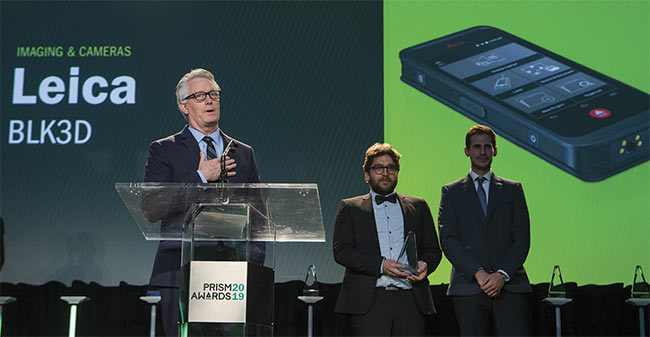
Hugh Baertlein, a vice president of Hexagon Geosystems, accepts the 2019 Prism Award in the Imaging and Cameras category on behalf of Leica Geosystems. Courtesy of SPIE/Joey Cobbs Photography.
The 2020 Prism Awards finalists, by category:
Communication
AUREA Technology (Besancon, France)
QUANTAXEA generates 10× more entangled photon pairs than any existing
photon source, according to AUREA Technology. The system features a narrow spectral width of 1 nm and outstanding visibility of 99%. It also includes on-
demand remote control capabilities and delivers novel properties compared to other photon sources by combining the benefits of proven optical fiber, waveguide, and high-quality laser technologies. AUREA said QUANTAXEA is the world’s first reliable, compact, easy-to-use commercial entangled photon pairs source that enables longer-distance deployments, more secure quantum networks, and new medical and life science instruments.
Cailabs (Rennes, France)
TILBA-R is a multiplane light-conversion-based spatial demultiplexer. It decomposes a beam wavefront profile perturbated by the atmospheric turbulence in a limited number of spatial modes. The
modes are collected and sent to single-mode fiber and then combined. This enables mitigating of atmospheric turbulence with a single, standard, passive off-the-shelf component that is compatible with standard optical fiber telecommunication components. The demultiplexer improves the reliability of a lasercom link with a single standard and affordable component in any possible situation, said Cailabs, reducing the cost of optical terminals, while being completely transparent for the customer in terms of implementation.

Guests at last year’s Prism Awards ceremony pose for a photo. Courtesy of SPIE/Joey Cobbs Photography.
Innolume GmbH (Dortmund, Germany)
The CW Datacom Laser is a high-power DFB (distributed feedback) laser featuring up to 180 mW at 100 °C. According to Innolume, the laser can provide 100 mW at the fixed current in the whole 25 to 100 °C temperature range. This makes the laser an attractive light source for uncooled operation. The product will support applications as a high-power, high wall-plug efficiency uncooled light source in data communications. It is geared toward developers and manufacturers of networking hardware, telecommunications equipment, and other high-technology services and products.
Energy
Innovations in Optics Inc. (Woburn, Mass.)
The Series 6000 LED Solar Simulator is a multiwavelength LED solar simulator for PV manufacturers that meets IEC 60904-9 Class AAA for spectral match and uniformity of irradiance, while exceeding the temporal stability requirements over a 50- × 50-mm irradiance field. Embedded chip-scale spectral sensors provide feedback monitoring to stabilize source irradiance. A digital driver/controller features an RS-485 interface with a Modbus/RTU communication protocol for remote operation. The 15-W power consumption is energy efficient and simplifies any thermal interface or active cooling scheme. According to Innovations in Optics, the compact size and lightweight design support a previously unattainable diversity of system integration concepts.
OSRAM Opto Semiconductors (Sunnyvale, Calif.)
OSRAM’s midpower LED, Osconiq S 3030 QD (Quantum Dot), was specially developed for area lighting and downlight applications and will enable customers to use luminaires with high efficiency and excellent color rendering. The product is useful for fixture manufacturers designing for the retail, office, hospitality, and education markets, with the target market being interior lighting, including architectural, hospitality, health care, residential, and commercial applications. The advantage of QD LEDs over CFLs (compact fluorescent light bulbs) for human-centric lighting applications is that they provide lighting at made-to-order color and color temperature.
Prisma Photonics (Tel Aviv, Israel)
According to Prisma Photonics, PrismaSense’s hyperscan fiber sensing system revolutionizes the transmission-lines monitoring market by enabling for the first time a high-fidelity and high-sensitivity monitoring solution with a low false-alarm rate and advanced classification capabilities. The system is able to detect and classify events such as network failure, flashovers, sawing, and human climbing. It can also detect and locate multiple simultaneous events. Each system can cover 100 km and monitor 250 towers.
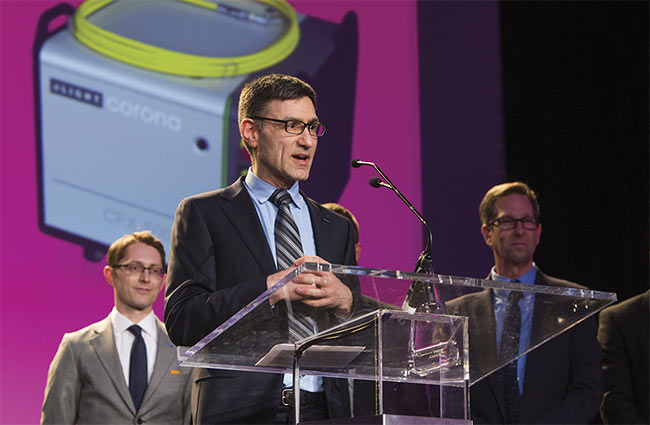
Dahv Kliner, a vice president of nLIGHT, accepts the company’s 2019 award in the Industrial Lasers category.
Health Care
Modulight (Tampere, Finland)
ML6710i lasers are iOS device-controlled medical devices for ophthalmology and neurosurgery. They can be used to locally activate photosensitive drugs and, according to Modulight, they produce significantly fewer side effects compared to systemic treatment. The mobile application uses AI-based analytics, which allow treatments to be guided based on in situ feedback. Doctors can use iOS devices to authenticate users and define treatment parameters and personal settings. Cloud connectivity enables price differentiation, pay-per-use business models, remote support, training, calibration, and information sharing across platforms.
Norlase ApS (Ballerup, Denmark)
The Norlase LEAF is an FDA-cleared, laser-based medical device for treating glaucoma and retinal diseases. Based on the latest semiconductor technology, Norlase said the LEAF drastically reduces size and cost compared to products currently on the market. The laser can be mounted directly on top of the doctor’s slit lamp and features voice control of treatment parameters. The core technology of the LEAF product takes full advantage of the recent development of visible semiconductor lasers, both in power and wavelengths.
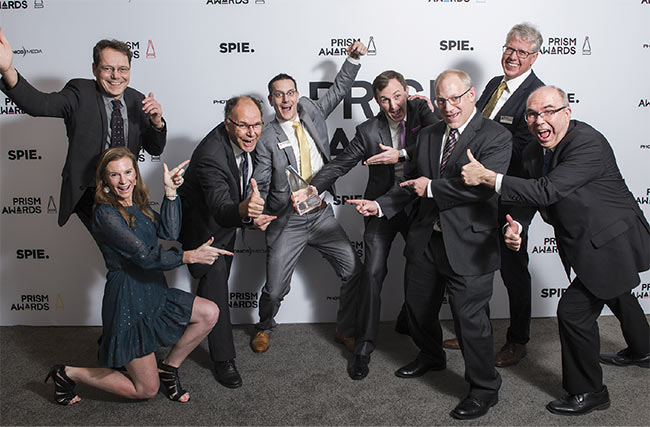
Representatives from TOPTICA Photonics pose for a photo with their 2019 award. The company won in the Scientific Lasers category.
PhotoniCare (Champaign, Ill.)
The TOMi Scope is a video otoscope that provides a high-quality video image of the eardrum surface and a depth view through the eardrum to directly visualize the middle ear contents. The depth view enables users to objectively determine the presence and density of fluid in the middle ear, providing up to 90% diagnostic accuracy, nearly doubling that of the gold standard of otoscopy (50%), according to PhotoniCare. Exams are quickly and easily shared with patients or placed into the EMR (electronic medical record), and the depth imaging portion of the exam may be submitted for reimbursement to insurance payers.
Life Sciences

Erik Laurin, a vice president of Photonics Media, delivers a speech at last year’s Prism Awards.
Celloptic Inc. (Rockville, Md.)
CINCHSCOPE is an all-optical confocal microscope that creates superresolved real-time images at any magnification or wavelength, with only one snap, based on an incoherent single-beam holographic principle using only a birefringent lens. According to Celloptic, a CINCHSCOPE-enabled microscope is able to provide better-resolved, highly informative images of samples at low cost and with the ease of use and maintenance of a standard fluorescence microscope. The microscope is well suited for the research market, with the typical customer being individual research labs that require facile and improved imaging resolution.
Hamamatsu (Bridgewater, N.J.)
The ORCA-Fusion camera uses a custom CMOS sensor designed from the ground up for low-light quantitative imaging. With a custom pixel design and state-of-the-art semiconductor processes, the camera offers improved pixel read noise and read noise uniformity and linearity. It outputs images and quantitative data directly from the camera, especially in low-light conditions. According to the company, the Gen III sCMOS sensor is the first with a unique fundamental pixel design and read-noise characteristics that surpass existing technology. The sensor includes well-accepted front-illuminated Gen II sCMOS and back-side illuminated sCMOS.

Representatives from CloudMinds Technology accept the 2019 award in the Detectors and Sensors category.
TERA-print (Skokie, Ill.)
The TERA-Fab E series delivers the nanoprinting experience with a combination of speed, resolution, design flexibility, and materials generality for a lower price, according to TERA-print. The platform seamlessly integrates state-of-the-art structured light illumination with ultraprecise optomechanics to enable rapid printing of millimeter-scale, arbitrary designs with a diffraction-unlimited (sub-250 nm) resolution, using massively parallel arrays of hundreds of thousands of independently actuatable near-field probes. A compact benchtop format, combined with a custom-built, user-friendly interface, makes the E series useful for researchers who need to prototype cutting-edge nanostructured devices.
Manufacturing
Inspekto (Tel Aviv, Israel)
The INSPEKTO S70 is a plug-and-play system for visual quality inspection that can be installed in 30 to 45 min without an external systems integrator or machine vision expertise. According to the company, the system is versatile and suitable for a wide variety of products and lines.
It can inspect multiple products simultaneously and can be moved and set up again in minutes to begin inspecting at another point on the line. The system is designed to appeal directly to the customer rather than the systems integrator.
IPG Photonics (Marlborough, Mass.)
The Smart Manufacturing System with Inline Quality Monitoring produces over 20 nondestructive metrics for each weld, including penetration depth, seam position, and surface quality. The data is stored in a comprehensive quality database to enable real-time observation, correction, and prediction of quality problems in the manufacturing line. When weld failures occur, the system alerts
operators to take corrective action, ensuring that normal operations begin quickly and that only good parts are sent to customers. The system is able to provide real-time laser-weld quality monitoring and database recording of high value and/or safety critical laser welds.
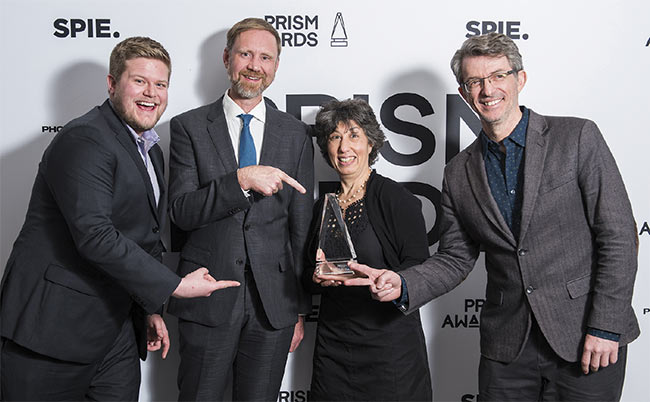
The Double Helix Optics team celebrates its 2019 win in the Diagnostics and Therapeutics category.
TRUMPF Lasertechnik GmbH (Ditzingen, Germany)
TOP Weld optics enables permanently joining transparent-to-transparent (e.g., glass to glass) or transparent-to-opaque (e.g., glass to metal) materials at room temperature without additional materials such as adhesives. Samples with large gaps up to 10 μm can be bridged (compared to 4 μm with conventional optics) and the focal tolerance is increased by ~200%. The optics enable freedom of
design due to a significantly reduced joining area, while keeping the joining strength high (compared to adhesive bonding).
Quality Control
CCS Inc. & EFFILUX SAS (Kyoto, Japan)
The EFFI-FLEX-HIS hyperspectral light is based on a single CCS LED
with a continuous spectrum from 400 to
900 nm. According to the company, this point source design provides exceptional spatial and spectral uniformity, enables lights in any form factor — including projector, bar, ring, and backlight — and solves problems associated with using halogen lamps or multiple LEDs.
CloudMinds Technology Inc. (Santa Clara, Calif.)
The Smart MEMs Handheld Raman XI2 is a cloud AI hand-held Raman spectrometer with MEMs scanning mirrors for area sampling. Using a Lissajous scanning mechanism, the laser beam is rapidly directed over a rectangular area that is linearly adjustable. According to CloudMinds, this fast-scanning mechanism minimizes the exposure of the laser beam to samples, so XI2 can be used for samples that tend to be burned or ignited by a laser, such as gunpowder. With XI2, Raman signal over a scanning area can be acquired for more accurate results. XI2 also adopts CloudMinds’ deep learning algorithm for multicomponent analysis at all sampling points to reveal a sample’s heterogeneity.
Si-Ware Systems (Cairo)
According to Si-Ware, the NeoSpectra-Scanner is the world’s first general-
purpose, hand-held spectral sensing device that operates in the higher end of the NIR spectral range. This hardware-ready solution, with a versatile ergonomic design, facilitates the process of transferring the power of NIR spectroscopy in performing material analysis from the lab to the field. The analysis models built with spectra collected with the NeoSpectra-Scanner enable performance of nondestructive, in-field material analysis for a wide variety of parameters simultaneously. Analysis can be performed for various types of samples, for classifying, quantifying, or qualifying in different application areas and domains.
Safety & Security
Allied Vision Technologies GmbH (Stadtroda, Germany)
According to Allied Vision, the Alvium camera series redefines the machine vision camera through its platform and ASIC-based architecture, combining the
performance and durability of an industrial machine vision camera with the size,
power consumption, and cost of an embedded sensor module. Alvium cameras have a built-in ISP that supports a comprehensive sensor range up to 21 MP
and 1.1-in. size. One driver covers all supported sensors for each platform, which dramatically reduces integration effort and cost. ALVIUM ASIC technology enables in-camera image correction, limiting the host’s needed processing power. The cameras offer MIPI CSI-2 and USB3 Vision interfaces, and they meet embedded and industrial vision standards.
Ophir Optronics Solutions Ltd. (Jerusalem)
The SupIR 50-1350mm f/5.5 is a high-performance IR thermal-imaging, continuous-zoom lens for MWIR-cooled detectors. It features a 50- to 1350-mm focal length based on a unique low-SWaP (size, weight, and power) and a folded-optic design suitable for advanced HD IR cameras and long-range surveillance applications. The design enables performance close to the diffraction limit over a detection range >25 km, suited for small-pixel VGA and HD IR cameras. The lens is optimized for stabilized payloads, with capabilities for high-resolution vision and identification in harsh environmental conditions and constrained platforms, while maintaining focus and tight line of sight with <2 pixels deviation.
Pendar Technologies (Cambridge, Mass.)
According to Pendar, the Pendar X10 is the only hand-held, point-and-shoot system that can identify almost any
material from up to 1 m away without the need for eye protection, and it is rugged enough for hazmat and narcotics applications. The system enables rapid chemical identification, including highly fluorescent, dark, and sensitive materials. No sample contact is required; measurements can be taken through plastic bags or windows. By increasing measurement distance and strongly reducing the risks of laser-induced explosion and eye damage, the system offers increased levels of safety, accuracy, and speed in the field. Simple point-and-shoot technology delivers results quickly (typically in <10 s).
Transportation
LeddarTech (Québec)
The Leddar Pixell is a 3D solid-state flash lidar that enables detection cocoons in autonomous shuttles and delivery vehicles, commercial vehicles, and robotaxis, providing dependable object and vulnerable road user (VRU) detection as well as exceptional durability, according to LeddarTech. Dependable object and VRU detection includes 3D flash illumination, providing 100% scene coverage, full-coverage over a 180° field of view, and no proximity dead zones or blind spots. Exceptional durability consists of 3D flash, a solid-state design with no moving parts, waterproof IP67-rated die-cast enclosure, UV- and corrosion-resistant components, windows with impact-resistant glass and hydrophobic coating, and automotive-grade connectors.
Outsight (Paris)
The Outsight 3D Semantic Camera brings full situation awareness in real time, in a single device, with localization, perception, and semantics, according to Outsight. The active 3D multispectral camera provides point-wise classification and material identification (including skin, plastic, snow, ice, asphalt, metal, and cotton), blended into a single 3D stream of data with 3D range and RGB, full vector velocity for each point, and SLAM on Chip (simultaneous localization and mapping). The device fuses a new broadband high-power laser source (SWIR band) with embedded software that provides advanced processing, such as classification and object detection, without requiring machine learning (no data sets).
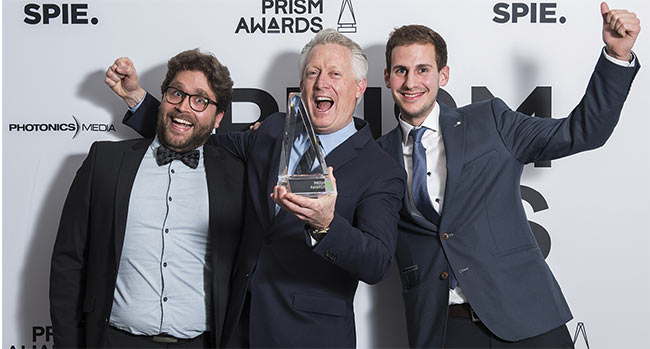
Leica Geosystems team members celebrate their 2019 win in the Imaging and Cameras category.
TriLumina (Albuquerque, N.M.)
The TriLumina 615 is a high-power VCSEL array for long-range lidar applications. According to the company, TriLumina enables broad lidar deployment and delivers inexpensive lidar illumination modules that are much smaller than alternative technologies, some smaller than the size of a dime. The TriLumina 615 is a back-emitting, flip-chip VCSEL array approach for performance and design flexibility.
Vision Technologies
Leica Geosystems (Newport, R.I.)
The BLK2GO is a lightweight, hand-held, wireless imaging laser scanner that uses SLAM technology and enables users to scan and capture complex spaces, environments, and objects in real time to create dimensionally accurate point clouds simply by walking through a space. The laser scanner continuously creates digital reality in motion. It collects 3D point clouds, panoramic images, and high-resolution detail images. It also uses simultaneous localization and mapping (GrandSLAM) technology that combines lidar, imaging, and inertial data. 3D mobile mapping and an iPhone app provide live 2D and 3D visualization, high-resolution images, monitoring of device status (including battery, storage, and connection strength), and visualization and management of existing scans.
LetinAR (Seoul, South Korea)
PinMR (Pin Mirror) Lens is an optical solution for augmented reality (AR) smart glasses. With the lens, manufacturers can build smart glasses that resemble conventional glasses. The simple structure of the lens module facilitates mass production. According to LetinAR, the PinMR Lens shows a wider virtual screen than the currently available optical systems, while more accurately expressing colors — providing an edge over diffraction- or refraction-based systems. The lens also shows a clear image without inducing dizziness because it extends the depth of field multiple times.
WaveOptics (Abingdon, England)
WaveOptics diffractive waveguides are key components in AR smart glasses and wearables. The company says its waveguides solve the two biggest challenges in scaling AR wearables: superior optical performance and low-cost mass manufacture. The technology produces the largest eye box possible, along with 2D pupil expansion methods, for binocular viewing with a wide field of view. Images are clear, crisp, and high contrast. The waveguides are lightweight and designed specifically to integrate into AR wearables, with mass manufacturing in mind. They can be customized to allow product differentiation, as well as manufactured at scale using standard industry processes.


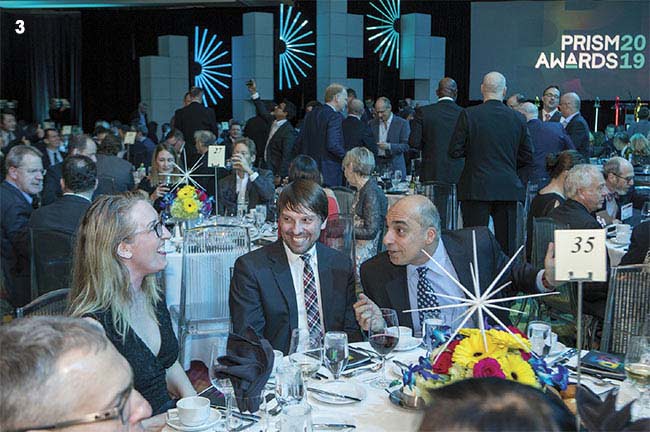
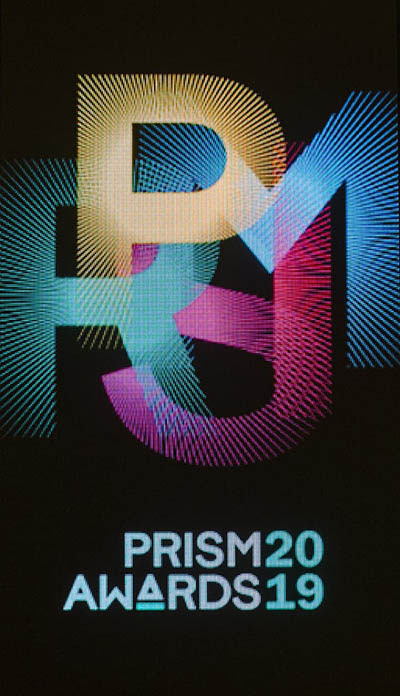


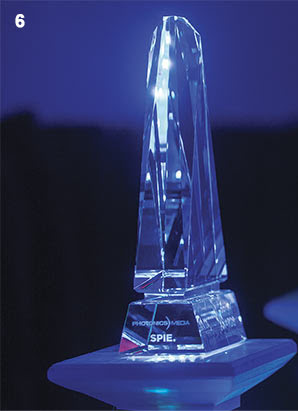

From top left: 1. Finalists and guests
enjoy food and drink before the 2019 Prism
Awards ceremony. 2. Jerry Panagrossi, executive director of Renevo Capital, delivers a speech
before last year’s ceremony. 3. Guests share a laugh. 4. Guests exchange information over a drink. 5. Michael Whitford, CEO and co-founder of Modular Photonics, walks off stage after accepting the 2019 award in the Optics and Optomechanics category. 6. The Prism Awards await their winners. 7. Guests share a laugh over dinner.